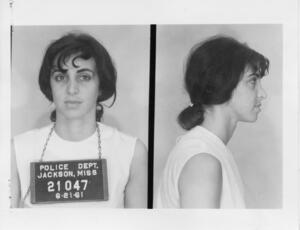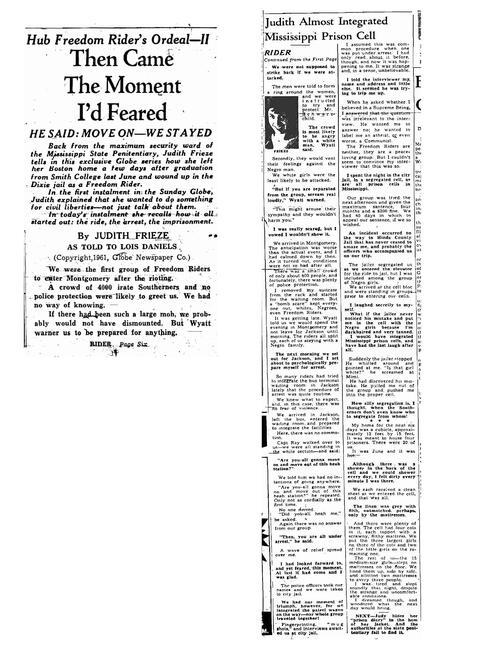Civil Disobedience: Freedom Rides
Discover the story of one young Jewish Freedom Rider and Gandhi's principles of civil disobedience, and prepare your own civil disobedience training video.
Overview
Enduring Understandings
- Civil disobedience was an important tool of the Civil Rights Movement.
- "Ordinary" people can effect change.
Essential Questions
- What is civil disobedience and how was it practiced in the Civil Rights Movement?
- What led young people to participate in the Civil Rights Movements and what sacrifices did they make?
Materials Required
- Chalk board, white board, or chart paper
- Copies of Scenario Worksheet
- Gandhi's Rules of Civil Disobedience (ideally copied on the reverse side of the Scenario Worksheet)
- Copies of Document Study
- Excerpts from Boston Globe articles on Judy Frieze's experience as a Freedom Rider
- Scanned copy of one of the original Boston Globe articles on Judith Frieze's experience as a Freedom Rider (part 2 of 8)
- Optional: video camera
- Optional: computer with wireless access, speakers, and projector, or Smart Board
- Poster board or construction paper
- Art supplies
Notes to Teacher
Note on language: Primary sources in this lesson include historical language that might be jarring to students unfamiliar with it in its context. The term “Negro,” in particular, was the accepted racial descriptor for Black Americans in the 1950s and early 60s and was not derogatory (as opposed to the N-word, which was and remains a hateful slur). For guidance on how to navigate and contextualize this language with students, we recommend this resource from Facing History and Ourselves.
This lesson plan centers on the story of one Jewish Freedom Rider, and includes articles and video of her story. If there are Freedom Riders living in your community, you may want to invite one of them to speak in your class or ask students to conduct video or audio interviews with them.
Electronic Archives of the Sovereignty Commission, Mississippi Department of Archives and History
The Electronic Archives of the Sovereignty Commission, Mississippi Department of Archives and History: mdah.state.ms.us/arrec/digital_archives/sovcom/. An extensive online collection of photographs and other documents from Mississippi's official counter civil rights agency, 1956-1973. Browse the photography collection (scroll down), use the keyword search, or enter the name of a freedom rider to find his/her mug shot, articles that mention that individual, and any other related materials.
Freedom Riders, a film by Stanley Nelson
Freedom Riders, a PBS American Experience documentary by Stanley Nelson, features extensive archival photographs and footage as well as recent interviews with riders, government officials, and journalists. It focuses on the leaders of the Freedom Rides, who faced tremendous violence, including the bombing of one of the first buses and brutal mob attacks. The trailer and excerpts from the film are available on the film's website at http://www.pbs.org/wgbh/americanexperience/freedomriders/watch. The film will premiere on PBS in May 2011. (More about the film and interviews with the filmmaker and two Freedom Riders can be found in a video segment from Democracy Now.) Facing History and Ourselves has developed a study guide for the film, which you can download at http://www.facinghistory.org/freedomriders.
Mississippi Freedom 50th
The website of the Mississippi Freedom 50th, a weeklong series of events to mark the 50th anniversary of the Freedom Rides, features a post about a Jewish Freedom Rider, Henry Schwarzschild, who in quoted describing how his Jewishness motivated his participation. The website also includes a video trailer that provides an overview of the Freeom Rides.
Freedom Riders: 1961 and the Struggle for Racial Justice
Arsenault, Raymond. Freedom Riders: 1961 and the Struggle for Racial Justice. New York: Oxford University Press, 2006. A thorough study of the Freedom Rides.
Breach of Peace: Portraits of the 1961 Mississippi Freedom Riders
Etheridge, Eric. Breach of Peace: Portraits of the 1961 Mississippi Freedom Riders. Atlas, 2008. A coffee table size book containing large images of Freedom Rider mugshots as well as recent photographs of select riders.
The King Center - Kingian Principles of Nonviolence
Kingian Principles of Nonviolence from The King Center, dedicated to the advancement of the legacy of Dr. Martin Luther King, Jr.





Judy and her husband Frank 'Sib" are wonderful people, my family and I am very blessed to have met them back in 1964 during the civil right era and we will always be eternally graful to them!!
I used the PBS film on Freedom Riders for this lesson. The segment titled "The Strategy" was particularly helpful. http://www.pbs.org/wgbh/americ...
I feel like we are missing something in this lesson. What do we do when you feel the "laws " such as segregation are wrong. How far are the students willing to go to right a wrong. This is a good lesson to teach about bystanders. Research shows that individuals are less likely to step up..civil disobedience ..when they are in a group than when they are by themselves for they feel someone else will step up. I would like to see some emphasis on " doing the right thing" even when others do not. There are written laws such as segregation and there are unwritten laws of segregation such as bullying.
It is important to stress what life was like then and not to make judgements based on our experiences of 2012. Today, it is not unusual for kids to talk back to parents, teachers or any authority. Back then, it was not acceptable to speak up r even travel alone as a woman.